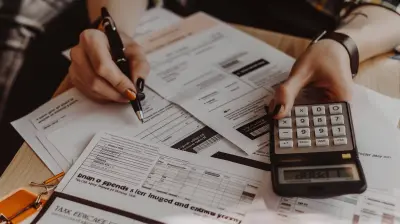How to Stop the Borrowing Cycle and Start Living Debt-Free
4 August 2025
Let’s be real for a second—if you’re reading this, chances are you’re stuck in the endless loop of borrowing money just to get by. Maybe payday loans feel like your only lifeline, or that credit card you swore you'd only use in emergencies is now maxed out... again. You're not alone. Millions of people are caught up in the borrowing cycle, and breaking free from it can feel like trying to run up an escalator that’s coming down.
But here’s the good news—you can get out. Truly. You can stop borrowing, start breathing, and finally live debt-free. This article is your roadmap. Not filled with complicated jargon or unrealistic advice, but with practical, heart-centered strategies that work.
Let’s dig in.
What Is the Borrowing Cycle?
Before you can break the cycle, you’ve got to understand what it is.The borrowing cycle usually looks something like this:
1. You fall short on cash for a bill or unexpected expense.
2. You borrow money—credit card, payday loan, maybe from friends.
3. You pay it back—barely—leaving you short again.
4. You borrow again… and again… and again.
It’s like having financial quicksand under your feet. The more you struggle, the deeper you sink. You’re not living—you’re surviving. That’s exhausting. But you're stronger than you think, and there is a way out.
Step 1: Acknowledge the Cycle Without Shame
First things first—let go of the guilt. Seriously.Debt is not a moral failure. Life happens. Expenses pile up. Jobs get lost. Kids need clothes. Medical bills show up uninvited. The world is expensive, and wages haven’t exactly kept up. Borrowing often feels like the only choice.
But acknowledging the cycle doesn’t mean beating yourself up. It means pausing, breathing, and saying, “Okay, this is where I am—but it’s not where I’ll stay.”
Give yourself that grace.
Step 2: Understand Why You Borrow
Here comes the soul-searching part.Borrowing is often a symptom, not the root. So ask yourself:
- Are you borrowing to cover the basics, like food or rent?
- Are you trying to maintain a lifestyle you can’t afford?
- Is emotional spending playing a role—like shopping for stress relief?
Knowing your “why” can help you spot the triggers. Once you understand the cause, you can start treating the problem and not just the symptoms.
Step 3: Take a Snapshot of Your Finances
You can’t change what you don’t measure. So grab a coffee, put on some calming music, and get honest with your money.Here’s how:
- List out all your income. Every dollar.
- Write down your fixed expenses—rent, utilities, phone, insurance.
- Add variable expenses—food, gas, subscriptions (yes, even Netflix).
- List every debt you owe—how much, the interest rate, and the minimum payments.
It’s not about judging yourself. It’s about shining a light into the dark corners so you can finally make a plan.
Step 4: Build a Budget That Works (Not One That Makes You Miserable)
Let’s ditch the word “budget” for a sec. Think of it more like a spending plan. A roadmap. A way to tell your money where to go instead of wondering where it went.Here’s a simple method to try:
The 50/30/20 Rule:
- 50% of income → Needs (rent, food, transportation).- 30% → Wants (dining out, hobbies, extras).
- 20% → Savings and debt repayment.
If your numbers don't fit this rule, that’s okay! Adjust where needed. The goal is to start somewhere.
Want to speed up debt repayment? Slash those wants and reroute the savings. Think of it as short-term pain for long-term peace.
Step 5: Emergency Fund—Your New Best Friend
What if, instead of a credit card, you had a mini safety net?Even a small emergency fund—like $500—can keep you from needing to borrow when your tire goes flat or your fridge dies. Start small. $5, $10, $20 per paycheck. Stash it in a separate savings account you don’t touch except for real emergencies.
That fund? It’s your “get-out-of-the-cycle” card.
Step 6: Crush Your Debt Strategically
Now comes the fun part—watching those debts fall like dominoes.Here are two debt payoff strategies to consider:
1. Snowball Method:
Start with your smallest debt. Make minimum payments on everything else. Throw any extra cash at the small one. When it’s gone, roll that payment into the next one. Momentum builds fast, and so does motivation.2. Avalanche Method:
List debts by interest rate, highest to lowest. Pay off the most expensive ones first. You’ll save the most money this way, though it might take longer to feel progress.Pick the method that fits your personality. Do you need quick wins to stay motivated? Go with snowball. Want to save every penny possible? Avalanche it is.
Step 7: Cut the Cord with Credit Cards and High-Interest Loans
This one's tough but necessary.If you truly want to break the cycle, stop feeding it. That means saying “no more” to credit cards, payday loans, and store financing.
Tips to help:
- Remove saved card info from online stores.
- Cut or freeze your cards—literally.
- Switch to debit or cash for daily expenses.
It may feel restrictive at first, but it’s actually freedom in disguise.
Step 8: Increase Your Income—Even a Little Bit Helps
Slashing expenses only gets you so far. At some point, you’ve got to widen the gap between income and outgo.Ideas to boost income:
- Ask for a raise or more hours at your current job.
- Pick up a side hustle—freelance, babysitting, rideshare, tutoring.
- Sell unused stuff around the house—clothes, gadgets, furniture.
Every extra dollar can go toward breaking the cycle faster. Think of your side hustle as your ticket to freedom.
Step 9: Learn to Live Below Your Means
This isn't about deprivation. It’s about liberation.Living below your means means spending less than you earn—consistently. It gives you breathing room, flexibility, and control.
Simple ways to make it happen:
- Meal plan and cook at home.
- Cancel subscriptions you don’t use.
- Embrace secondhand—thrift stores, marketplace deals.
- Delay gratification. Pause before purchases, ask yourself, “Do I really need this?”
Frugal isn't a dirty word. It’s your secret weapon.
Step 10: Set Small, Meaningful Financial Goals
Big goals are inspiring, but small ones are achievable. And achieving small goals builds confidence.Examples:
- Save $100 in one month.
- Stick to your spending plan for one week.
- Pay off one credit card in three months.
Celebrate every milestone, no matter how tiny. You're reversing habits that took years to build. That’s no small thing.
Step 11: Surround Yourself with Support
Money can be emotional. Don’t go it alone.Seek support from:
- A trusted friend or family member who won’t shame or judge.
- Online debt-free communities (Reddit, Facebook, YouTube).
- A nonprofit credit counselor (not a debt settlement company!).
You need cheerleaders, not critics. People who’ll remind you of your goals on the hard days.
Step 12: Practice Financial Mindfulness and Gratitude
Stay present with your money. Instead of dreading your finances, check in with curiosity. Ask yourself:- How did I feel about money today?
- What spending decisions felt good? Which didn’t?
- What am I grateful for—right now?
Gratitude shifts your mindset from lack to abundance. And that mental shift? It’s the true key to lasting change.
Final Thoughts: You Deserve a Life of Peace, Not Payments
Look—you’re not weak for borrowing. You’re strong for recognizing it's time to stop. You’re courageous for facing the numbers. And you’re amazing for deciding to take control.Breaking free from the borrowing cycle isn’t just about money. It’s about reclaiming your life. It’s about sleeping peacefully, dreaming again, and living on your terms.
You’ve got this.
One step at a time.
One choice at a time.
And pretty soon? The cycle will be nothing but your past.
all images in this post were generated using AI tools
Category:
Debt Free LivingAuthor:

Knight Barrett
Discussion
rate this article
1 comments
Cynthia Cain
Empowering tips for a brighter financial future!
August 15, 2025 at 10:21 AM

Knight Barrett
Thank you! I'm glad you found the tips helpful for achieving financial freedom!


